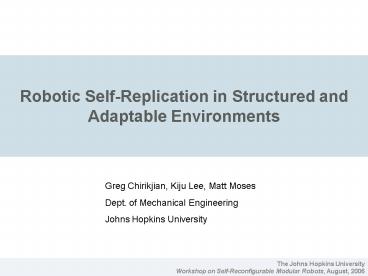The Johns Hopkins University - PowerPoint PPT Presentation
Title:
The Johns Hopkins University
Description:
Greg Chirikjian, Kiju Lee, Matt Moses. Dept. of Mechanical Engineering. Johns Hopkins University ... Our First Self-Replicating Robots in Structured Environments ... – PowerPoint PPT presentation
Number of Views:95
Avg rating:3.0/5.0
Title: The Johns Hopkins University
1
Robotic Self-Replication in Structured and
Adaptable Environments
Greg Chirikjian, Kiju Lee, Matt Moses Dept. of
Mechanical Engineering Johns Hopkins University
2
Contents
- Our First Self-Replicating Robots in Structured
Environments - Self-Replicating Robots in Semi-Structured
Environments - Self-Assembling Computers
- Self-Replicating Robots with Discrete Electronics
- Self-Replicating Robots that Structure Their
Environment - Future Directions
- Develop Principles of Robotic Entropy/Disorder
- Robotic Self-Replication by Mitosis
3
A Remote Controlled Design
4
A Fully Autonomous SRR
5
Robotic Self-Repair in a Semi-Structured
Environment
6
Robotic Self-Repair in a Semi-Structured
Environment
7
Computers that Copy Themselves
- To make computers from logic elements
- using a von Neumann Universal Constructor
- would require a very complicated code.
- An alternative is Laings paradigm of
self-replication - by self-inspection. We developed three prototypes
to - demonstrate this idea physically for the first
time.
8
Self-Replication by Self-Inspection 1
9
Self-Replication by Self-Inspection 2
10
Self-Replication by Self-Inspection 3
11
Combining Previous Concepts
- Self-Replicating Robots with Distributed
Computing Elements
12
SRR with Distributed Circuits
13
SRR with Distributed Circuits
14
SRR in Adaptable Environment
15
SRR in Adaptable Environment
16
Remainder of the Talk
- Principles of Robotic Self-Replication (RSR)
- Universality, High Relative Complexity,
Robustness, and Efficiency - Entropy/Information
17
Principles
- Universality
- What can it become?
- What can it produce?
- What functions can it perform?
- High Relative Complexity
- Complexity of the Robot vs. Complexity of the
Individual Parts - Robustness
- Error tolerance in sensing and manipulation
- Efficiency
- How efficiently can it reproduce?
18
Entropy
- Entropy is
- A potential useful tool to describe the
sophistication of tasks in robotic
self-replication - A measure useful when the environment can be
defined by any element of an ensemble of
different configurations - A property of the collection of all environmental
objects over all of their possible arrangements.
19
Entropy
20
Pose Entropy
Assuming that each body can move independently
An estimated overlap of rigid bodies i and j
Then we have,
21
Future A Self-Replicating Lunar Factory System
22
Selected References
- Suthakorn, J., Andrew B. Cushing, and Chirikjian,
G.S. - An Autonomous Self-Replicating Robotic
System, - Proceedings of the 2003 IEEE/ASME International
- Conference on Advanced Intelligent Mechatronics,
2003 - Chirikjian, Zhou, Y. and G.S, Suthakorn,
- Self-Replicating Robots for Lunar
Development, - ASME IEEE Transactions on Mechatronics
- Vol. 7, Issue 4, Dec 2002.
- For more
- http//custer.me.jhu.edu/publication/self_replicat
ing.html

